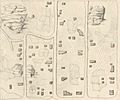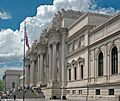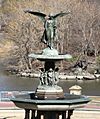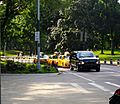Central Park facts for kids
Quick facts for kids Central Park |
|
|---|---|
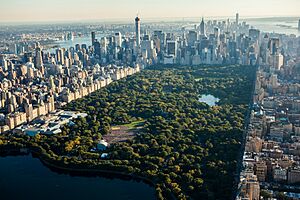
Aerial view of southern Central Park (September 2014)
|
|
| Type | Urban park |
| Location | Manhattan, New York City, New York, U.S. |
| Area | 843 acres (341 ha; 1.317 sq mi; 3.41 km2) |
| Created | 1857–1876 |
| Owned by | NYC Parks |
| Operated by | Central Park Conservancy |
| Visitors | about 42 million annually |
| Open | 6:00 a.m. to 1:00 a.m. |
| Public transit access | Subway and bus; see "Public transport" |
| Architect | Frederick Law Olmsted (1822–1903), Calvert Vaux (1824–1895) |
| NRHP reference No. | 66000538 |
| Significant dates | |
| Added to NRHP | October 15, 1966 |
| Designated NHL | May 23, 1963 |
Central Park is an urban park between the Upper West Side and Upper East Side neighborhoods of Manhattan in New York City that was the first landscaped park in the United States. It is the sixth-largest park in the city, containing 843 acres (341 ha), and the most visited urban park in the United States, with an estimated 42 million visitors annually as of 2016[update].
The creation of a large park in Manhattan was first proposed in the 1840s, and a 778-acre (315 ha) park approved in 1853. In 1857, landscape architects Frederick Law Olmsted and Calvert Vaux won a design competition for the park with their "Greensward Plan". Construction began the same year; existing structures, including a majority-Black settlement named Seneca Village, were seized through eminent domain and razed. The park's first areas were opened to the public in late 1858. Additional land at the northern end of Central Park was purchased in 1859, and the park was completed in 1876. After a period of decline in the early 20th century, New York City parks commissioner Robert Moses started a program to clean up Central Park in the 1930s. The Central Park Conservancy, created in 1980 to combat further deterioration in the late 20th century, refurbished many parts of the park starting in the 1980s.
Main attractions include landscapes such as the Ramble and Lake, Hallett Nature Sanctuary, the Jacqueline Kennedy Onassis Reservoir, and Sheep Meadow; amusement attractions such as Wollman Rink, Central Park Carousel, and the Central Park Zoo; formal spaces such as the Central Park Mall and Bethesda Terrace; and the Delacorte Theater. The biologically diverse ecosystem has several hundred species of flora and fauna. Recreational activities include carriage-horse and bicycle tours, bicycling, sports facilities, and concerts and events such as Shakespeare in the Park. Central Park is traversed by a system of roads and walkways and is served by public transportation.
Its size and cultural position make it a model for the world's urban parks. Its influence earned Central Park the designations of National Historic Landmark in 1963 and of New York City scenic landmark in 1974. Central Park is owned by the New York City Department of Parks and Recreation but has been managed by the Central Park Conservancy since 1998, under a contract with the municipal government in a public–private partnership. The Conservancy, a non-profit organization, raises Central Park's annual operating budget and is responsible for all basic care of the park.
Contents
Size
The Central Park is 2.5 miles (4 km) long between 59th Street (Central Park South) and 110th Street (Central Park North), and is 0.5 miles (0.8 km) wide between Fifth Avenue and Central Park West. It is similar in size to San Francisco's Golden Gate Park, Chicago's Lincoln Park, Vancouver's Stanley Park, or Munich's Englischer Garten. It lies between the New York Theater District, Harlem (north), Upper West Side, and the Upper East Side.
Central Park is bordered on the north by West 110th Street, on the south by West 59th Street, on the west by Eighth Avenue, and on the east by Fifth Avenue. Along the park's borders however, these are known as Central Park North, Central Park South, and Central Park West, respectively. Only Fifth Avenue retains its name as the eastern border of the park. Each of the twenty gates on these streets has a name.
The park is bigger than Monaco and Vatican City, though some other parks in the city are even larger.
History
In 1855, New York City had four times as many people as in 1821. The city grew bigger, and there were fewer parks in Lower Manhattan. A park was being planned for Upper Manhattan. Two years before, in 1853, the New York state government gave over an 700-acre (280 ha) area, from 59th to 106th Streets, to build the Park. The land alone cost more than US$5 million.
The park first opened in 1857. In 1858, Frederick Law Olmsted and Calvert Vaux won a design competition to improve and expand the park with a plan they entitled the Greensward Plan. Construction began in the same year and was finished in 1873. Many rocks, soil, and plants were put in the park. People living in the park were forced to move out. Later, the park was made larger.
In the 1930s, because people had not taken care of the park, it was cleaned up and changed by Robert Moses. By the 1960s, the park became a bad place to go again, so in the 1980s and 1990s, the Central Park Conservancy was made. The Central Park Conservancy cleaned up Central Park from the 1980s through the 2000s.
The park was named a National Historic Landmark in 1963.
Central Park Conservancy
The Central Park Conservancy runs the park. They operate it because of an agreement with the city government. 85% of Central Park's $25 million annual budget and 80% of the park's maintenance staff come from the Conservancy.
The conservancy cares for 250 acres of lawns, 21,500 trees, 150 acres of lakes and streams, and 130 acres of woodlands. Their staff plant hundreds of bulbs, shrubs, flowers, and trees every year. They make sure that 9,000 benches, 26 ballfields, and 21 playgrounds are clean and good to use. They also care for 55 sculptures and monuments, as well as 36 bridges. Conservancy crews remove graffiti from Central Park and collect more than 2,000 tons of trash a year!
The Conservancy has been led by four presidents. The first is Elizabeth Barlow Rogers, who helped to create the Conservancy in 1978. She was president until 1996. Karen H. Putnam, the Conservancy’s development director, was president from 1996 to 2000, after completing the projects slated under the Wonder of New York capital campaign. The third, Regina S. Peruggi, used to be president of Marymount Manhattan College. She led the Conservancy from 2000 to 2003. Since 2003, Douglas Blonsky, who used to look over construction for the Park, has been the president of the Conservancy.
Visitors
Central Park is the most visited urban park in the United States and one of the most visited tourist attractions worldwide, with 42 million visitors in 2016. The number of unique visitors is much lower; a Central Park Conservancy report conducted in 2011 found that between eight and nine million people visited Central Park, with 37 to 38 million visits between them. By comparison, there were 25 million visitors in 2009, and 12.3 million in 1973.
The number of tourists as a proportion of total visitors is much lower: in 2009, one-fifth of the 25 million park visitors recorded that year were estimated to be tourists.
Wildlife
Central Park is biologically diverse. A 2013 survey of park species by William E. Macaulay Honors College found 571 total species, including 173 species that were not previously known to live there.
Flora
According to a 2011 survey, Central Park had more than 20,000 trees, representing a decrease from the 26,000 trees that were recorded in the park in 1993. The majority of them are native to New York City, but there are several clusters of non-native species. With few exceptions, the trees in Central Park were mostly planted or placed manually. Over four million trees, shrubs, and plants representing approximately 1,500 species were planted or imported to the park. In Central Park's earliest years, two plant nurseries were maintained within the park boundaries: a demolished nursery near the Arsenal, and the still-extant Conservatory Garden. Central Park Conservancy later took over regular maintenance of the park's flora, allocating gardeners to one of 49 "zones" for maintenance purposes.
Central Park contains ten "great tree" clusters that are specially recognized by NYC Parks. These include four individual American elms and one American elm grove; the 600 pine trees in the Arthur Ross Pinetum; a black tupelo in the Ramble; 35 Yoshino cherries on the east side of the Onassis Reservoir; one of the park's oldest London plane trees at 96th Street; and an Euodia at Heckscher Playground. The American elms in Central Park are the largest remaining stands in the Northeastern United States, protected by their isolation from the Dutch elm disease that devastated the tree throughout its native range. There are several "tree walks" that run through Central Park.
Fauna
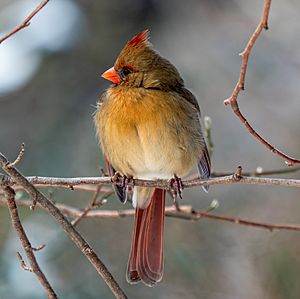
Central Park contains various migratory birds during their spring and fall migration on the Atlantic Flyway. The first official list of birds observed in Central Park, which numbered 235 species, was published in Forest and Stream in 1886 by Augustus G. Paine Jr. and Lewis B. Woodruff. Overall, 303 bird species have been seen in the park since the first official list of records was published, and an estimated 200 species are spotted every season. No single group is responsible for tracking Central Park's bird species. Some of the more famous birds include a male red-tailed hawk called Pale Male, who made his perch on an apartment building overlooking Central Park in 1991. A mandarin duck nicknamed Mandarin Patinkin received international media attention in late 2018 and early 2019 due to its colorful appearance and the species' presence outside its native range in East Asia. Another bird, an Eurasian eagle-owl named Flaco, gained attention in 2023 when he escaped from the Central Park Zoo after his enclosure was vandalized. More infamously, Eugene Schieffelin released 100 imported European starlings in Central Park in 1890–1891, which led to them becoming an invasive species across North America.
Central Park has approximately ten species of mammals as of 2013[update]. Bats, a nocturnal order, have been found in dark crevices. Because of the prevalence of raccoons, the Parks Department posts rabies advisories. Eastern gray squirrels, eastern chipmunks, and Virginia opossums inhabit the park. A 2019 squirrel census found there were 2,373 Eastern Gray squirrels in Central Park.
There are 223 invertebrate species in Central Park. Nannarrup hoffmani, a centipede species discovered in Central Park in 2002, is one of the smallest centipedes in the world at about 0.4 inches (10 mm) long. The more prevalent Asian long-horned beetle is an invasive species that has infected trees in Long Island and Manhattan, including in Central Park.
Turtles, fish, and frogs live in Central Park. There are five turtle species: red-eared sliders, snapping turtles, painted turtles, musk turtles, and box turtles. Most of the turtles live in Turtle Pond, and many of these are former pets that were released into the park. The fish are scattered more widely, but they include several freshwater species, such as the snakehead, an invasive species. Catch and release fishing is allowed in the Lake, Pond, and Harlem Meer. Central Park is a habitat for two amphibian species: the American bullfrog and the green frog. The park contained snakes in the late 19th century, though Marie Winn, who wrote about wildlife in Central Park, said in a 2008 interview that the snakes had died off.
In popular culture
Central Park has been mentioned in thousands of books, movies, and TV shows. In the U.S. TV show Friends (1994-2004), the coffee shop where the characters often gathered was named "Central Perk" as a pun on the term "coffee percolator" (a type of pot used to brew coffee).
Images for kids
-
Map of the former Seneca Village from Viele's survey for Central Park
-
Bethesda Terrace and Fountain under construction in 1862
-
Belvedere Castle, completed 1869
-
Angel of the Waters (1873) in Bethesda Fountain
-
Cleopatra's Needle, the park's oldest man-made structure
-
Entrance to the Fifth Avenue–59th Street subway station just outside Central Park
See also
 In Spanish: Central Park para niños
In Spanish: Central Park para niños





